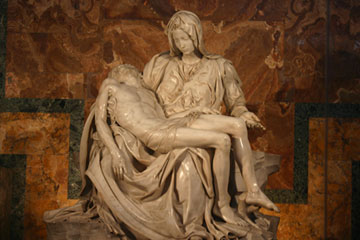



 |
||||||
| Newsletters Summer Newsletter, 2005 Volume 2, Issue 3
|
||||||
|
What do we mean when we say we believe in the Real Presence? What do we mean by real, and how is God's presence in The Eucharist different from His presence everywhere else?
There are different types of reality that we speak of. A physical reality is something we can perceive with our senses; something we can see, touch and examine. A spiritual reality is something which exists but which is not material; it is spiritual such as an angel, demon, or a soul. Then there is a sacramental reality which transcends physical and spiritual realities containing elements of both. The reality of the Eucharist is one such sacramental reality: something we come to know by faith. The Eucharist is the body of Christ, because Christ Himself said, “This is my body,” and His Church has confirmed this truth for 2,000 years. We accept it on faith, a rational faith, confirmed by our acknowledgement of the historical miracles of Jesus, and also the documented Eucharistic miracles which confirm the sacramental reality with real physical signs. Transubstantiation: The Council of Trent coined this term to describe what occurs at the consecration of The Eucharist. It is a change in the substance of the bread into the substance of the body of Christ, and the substance of the wine into the substance of his blood. Substance is the essence of what something truly is, not just its accidental appearance. After the consecration, there is no longer any bread in the host despite its physical appearance. It is the body of Christ. This is what we mean by real. We accept it and believe it. A Unique Type of Presence: God is present everywhere. The Trinity dwells within our own souls. Christ said that when two or more are gathered in His name, He will be present. Christ is now glorified in heaven in His entirety, so when we speak of Christ becoming present at a gathering, or when we approach Him in prayer, it is the whole Christ, body, soul and divinity that we are speaking of. Isn't this the same presence that is spoken of when referring to The Eucharist? What makes it different? God was already present in Bethlehem before Jesus was born there, yet He became present to us in a different way: through the incarnation. This different type of presence had a purpose: God became present as a man so that He could suffer and die for us. The presence in the Eucharist is like this; a different type of presence with a specific purpose. Primarily speaking, the presence in the Eucharist is exactly what the priest says it is when he gives you the host: “The Body of Christ.” It is what is represented by a crucifix, or Michaelangelo's Pieta: the lifeless body of Christ, that is, Christ at the moment of His immolation 2,000 years ago. The Eucharist is Christ made present on our altars just after His death. His dead body is the sacrificed lamb of God, the perfect and perpetual sacrifice to God the Father. The Purpose of Sacrifice: This sacrifice is made in honor of God, in thanksgiving and in reparation for sin. In the mass, the perfect sacrifice of Christ is made present so that we can offer praise and glory to God, offer thanksgiving and seek forgiveness for our sins by offering the actual sacrificed body of Christ up to The Father. We then share in communion, by taking the body of Christ into our own bodies. As Christ said, unless you eat the flesh of the Son of Man you have no life in you. How can we take in the flesh of the Son of Man, unless we have that flesh present before us? This is the presence of God in the Eucharist that makes it different. It is a unique presence of Christ with a purpose. But we also know that it is not just the dead body of Christ that is present in the Eucharist, but the whole Christ, body, blood, soul, and divinity. The Hypostatic Union: Christ has two distinct natures: human and divine, yet He is one person. His human and divine natures are fused in what is termed the "hypostatic union." Wherever His human nature is, there is His divine nature. At the current time, Christ is no longer dying on the cross at Golgotha, but is glorified in heaven. When Christ immolated on the cross 2,000 years ago is made present on the altar, He is really Christ, not a copy or shadow of Christ. So when His body and blood from the sacrifice at Golgotha is brought to the present moment, it is one with His body, blood, soul and divinity glorified in heaven. That is why when we receive the body of Christ, while it is the re-presenting of the sacrificed (dead) Christ, we are also receiving the full, living body and blood of Christ along with His soul and divinity. But if we forget the primary reality of the Eucharist, that of it being the body of Christ, we tend to forget how the presence of God in the Eucharist is any different from the presence of God everywhere, and the Eucharist becomes merely a symbol in our minds instead of the unique, awesome and powerful presence of God that it is. Newsletters: Evolution
Copyright © 2005 A Drop of Clear Water |
||||||